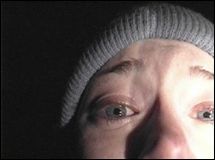![[Deep Focus]](../../flicker/logo.gif) |
|
|
THE BLAIR WITCH PROJECT | |
 |
GRADE: A- | Into the woods. |
Truly shot on a shoestring budget, with postproduction niceties (like the year's coolest sound mix) added by distributor Artisan Entertainment, The Blair Witch Project is already one of the most profitable films ever made. Can we attribute its outsize performance, finally, to the mass audience's impatience with the cookie-cutter crap being made by hacks like Jan de Bont and getting shoehorned into shopping malls nationwide by big Hollywood studios? Audacious, edgy, and completely unlike anything else showing at the multiplex, this is that rarity in contemporary cinema -- an instant classic. A vocal minority of online horror buffs have scoffed at the film's premise -- three student filmmakers venture into the Maryland woods to shoot a documentary about creepy goings-on in the area and are never heard from again; a year later, their footage is discovered, edited, and finally released to the public as The Blair Witch Project. That's also, you see, the basic premise behind Cannibal Holocaust, a cheapie flick of the cannibal horror genre that flourished in Italy during the 1970s. The comparison would be hopeless even if this sort of "mockumentary" weren't a time-honored device, in both film and literature (Poe used it to similar effect in The Narrative of Arthur Gordon Pym), because Cannibal Holocaust and Blair Witch are polar opposites. The difference between the two films can be seen by comparing their two signature images -- in Cannibal Holocaust, that would be the famous shot (often mistaken for "snuff") of a woman impaled on a spike; in Blair Witch, it's nothing more than some teeth and a bit of hair. In marked contrast to movies (like Cannibal Holocaust) that go for visceral impact by realizing outrageous gruesomeness on-screen, The Blair Witch Project is horror by implication. Its cheapie premise pretty much precludes the sort of elaborate, self-aware and self-mocking filmmaking that characterizes Scream and its numerous knock-offs. Heather Donahue, Michael C. Williams and Joshua Leonard play the three eponymous filmmakers who quiz locals on infamous bits of local history, including the legend of a woman known as the Blair Witch. The three then venture into the woods to visit the sites of certain grisly events. Before long, they get the sense that someone or something is playing games with them. And when their map disappears and their compass stops working, panic sets in. The woods serve the same function here as they do in a few other contemporary horror films, notably the similarly gritty The Evil Dead. The wilderness setting suggests how easy it is to become lost in the forest, emphasizing the characters' ever-more-tenuous connection with the known world. The trees themselves conceal the unseen, the unknown, and the unthinkable. They connect fear with ideas about the unexplored corners of our environment, suggesting that the natural world encompasses events and entities that are still unknowable by scientific means of inquiry. Primal stuff, this, given potent expression on the screen by a savvy move on the part of the filmmakers. The three actors, you see, were recruited with the caveat that they would be sent into the woods for something like a week of camping and improvisational filmmaking. The actors received notes on their daily agenda from the two directors, who hung around nearby, ready to pull some stunt or another in the middle of the night to keep the performers tired and on edge. That particular gamble paid off in spades -- the performances become more ragged and more desperate as the film wears on and the characters begin to lose their bearings and crack up. My only real complaint with the film is that entirely too much screen time is given over to these college students yelling at each other, endlessly -- but at least those scenes have the edge of uneasy verisimilitude. The film even has a neat subtext, anticipating complaints that a trio of college students who really were in mortal danger out there in the woods would, at some point, turn off the damn cameras and just worry about surviving. One of the characters actually asks Heather, obviously the instigator of this expedition, why she's still obsessed with making her little movie, once everything has gone horribly wrong. Let me keep filming, she entreats him. "It's all I have left." Well, OK. Your reaction to that kind of business will depend on whether the film's powerful mojo is working on you. A friend reported back from an early screening that the hype was unfounded: "If you think that stick figures and little piles of stones are scary, well, be my guest." Judging from audience reaction at the (sold-out) screening I attended, he's not alone in that regard -- lots of after-show muttering indicated that many were nonplussed. Then again, someone in the audience actually screamed during the film, always a sign that it's working on someone. Me, I agree with some criticisms that the film is a stunt, but so what? It's a really, really good stunt, with at least one indelible, bone-chilling image. Boasting moments of pure hysteria and fixating on what lurks, unseen, outside of the frame, The Blair Witch Project does triple duty as a horror pic, a lesson in narrative economy, and a meditation on the terror of filmmaking -- it's the cinema's equivalent of a spooky, enduring campfire tale. |
|
|
Written, directed and edited by Daniel Myrick and Eduardo Sánchez Starring Heather Donahue, Michael C. Williams, and Joshua Leonard Theatrical aspect ratio: 1.33:1 ("windowboxed" within 1.85:1 projected frame) USA, 1999 |
|
|
|
|

 http://www.deep-focus.com/dfweblog/
bryant@deep-focus.com
http://www.deep-focus.com/dfweblog/
bryant@deep-focus.com